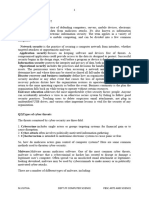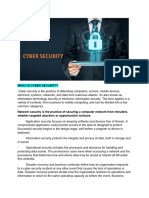Reserach About Cyber Security
Reserach About Cyber Security
Uploaded by
maha13aljasmiCopyright:
Available Formats
Reserach About Cyber Security
Reserach About Cyber Security
Uploaded by
maha13aljasmiCopyright
Available Formats
Share this document
Did you find this document useful?
Is this content inappropriate?
Copyright:
Available Formats
Reserach About Cyber Security
Reserach About Cyber Security
Uploaded by
maha13aljasmiCopyright:
Available Formats
Introduction:
The digital age has brought about unprecedented technological advancements that have
transformed the way we live, work and interact with one another. With these
advancements, however, come new and complex challenges that have given rise to the need
for strong cyber security measures. Cyber security refers to the practice of protecting
computer systems, networks, and digital information from unauthorized access, theft, or
damage. As more data is stored online, the need for strong cyber security measures
becomes increasingly important. In this research paper, we will explore the importance of
cyber security, the types of cyber threats, and the best practices for staying safe in the digital
world.
Body Paragraph 1: Importance of Cyber Security
Cyber security is essential for protecting personal and sensitive information from cyber-
attacks. In today's digital age, data is a valuable commodity, and without adequate security
measures, hackers can steal personal information, such as credit card details, social security
numbers, and other sensitive data. The consequences of such breaches can be dire, leading
to financial loss, identity theft, and reputational damage. The importance of cyber security
cannot be overstated, as it is critical for maintaining trust and confidence in digital
transactions.
In addition, cyber threats can also pose a significant risk to businesses and governments. For
organizations, cyber attacks can lead to data breaches that can compromise sensitive
information, disrupt operations, and cause financial harm. Governments may also be
targeted by cyber attacks aimed at disrupting critical infrastructure, stealing state secrets, or
compromising national security. The impact of such attacks can be far-reaching, and the
need for strong cyber security measures has never been greater.
Body Paragraph 2: Types of Cyber Threats
There are various types of cyber threats that individuals and organizations should be aware
of. One of the most common types of cyber threats is malware, which is a malicious
software that is designed to damage or disrupt computer systems, steal sensitive
information, or gain unauthorized access to networks. Malware can be spread through
various means, including email attachments, infected websites, or infected software
downloads.
Another common cyber threat is phishing, which is an attempt to trick users into revealing
their personal information through fraudulent emails or websites. Phishing attacks can be
particularly effective because they often appear to be legitimate, and users may unwittingly
provide their login credentials or other sensitive information to the attackers.
Ransomware is another type of cyber threat that has gained notoriety in recent years.
Ransomware is a type of malware that locks users out of their systems or files until a ransom
is paid. Attackers may also threaten to publish sensitive information unless a ransom is paid.
Ransomware attacks can be devastating for individuals and organizations alike, and
prevention is key to avoiding these attacks.
Body Paragraph 3: Best Practices for Cyber Security
To protect against cyber threats, it is essential to follow best practices for cyber security.
One of the most basic practices is to use strong passwords that are difficult to guess.
Additionally, keeping software up-to-date is crucial, as updates often include important
security patches that can address vulnerabilities.
Using antivirus software is also essential for protecting against malware, and individuals and
organizations should also avoid suspicious emails and websites. Regularly backing up data is
also important, as it can help to minimize the damage caused by a ransomware attack or
other data breach.
Furthermore, individuals and organizations should implement two-factor authentication, use
virtual private networks (VPNs), and limit access to sensitive information. Two-factor
authentication adds an extra layer of security by requiring users to provide additional
information or verify their identity before logging in. VPNs can provide additional security by
encrypting online activity and masking the user's location.
Conclusion:
In conclusion, cyber security is an essential aspect of the digital world. With the increasing
reliance on technology, cyber threats are becoming more sophisticated and frequent. It is
therefore important for individuals
You might also like
- Cyber Security AssignmentDocument9 pagesCyber Security Assignmentusama100% (1)
- File Based Approach Vs Database ApproachDocument14 pagesFile Based Approach Vs Database ApproachChevannese Ellis50% (2)
- The Importance of Cybersecurity in The Modern Digital EraDocument3 pagesThe Importance of Cybersecurity in The Modern Digital EraAsif AliNo ratings yet
- Cyber SecurityDocument3 pagesCyber SecurityrajeNo ratings yet
- 14 Cyber Security Awareness 1Document9 pages14 Cyber Security Awareness 1Michelle EsternonNo ratings yet
- Cyber Security Notes 3Document2 pagesCyber Security Notes 3Kapil VermaNo ratings yet
- Computer and Internet CrimeDocument7 pagesComputer and Internet CrimeNaomi CañoNo ratings yet
- Cyber Security AssignmentDocument9 pagesCyber Security Assignmentdeepakkumar011singhNo ratings yet
- System Analysis and DesignDocument13 pagesSystem Analysis and DesigncakiirceydaNo ratings yet
- Let The Picture SpeakDocument6 pagesLet The Picture SpeakASHA KAINDALNo ratings yet
- The Invisible ThreatDocument5 pagesThe Invisible ThreatRichie Darren TanNo ratings yet
- NoteDocument7 pagesNotemahimasharma9930No ratings yet
- ReportDocument11 pagesReportpriyanshu11sharma11No ratings yet
- Introduction To Cyber Security IIIDocument7 pagesIntroduction To Cyber Security IIINandini DaggupatiNo ratings yet
- Cyber Security IssuesDocument3 pagesCyber Security IssueskennethbusilanNo ratings yet
- Main Report For Cyber Crime and Its PreventionDocument9 pagesMain Report For Cyber Crime and Its PreventionstusineNo ratings yet
- DE Assignment 2Document7 pagesDE Assignment 2sara maheshwariNo ratings yet
- Comprehensive Guide to Personal Cybersecurity: Personal Cybersecurity Practices for a Safer Digital LifeFrom EverandComprehensive Guide to Personal Cybersecurity: Personal Cybersecurity Practices for a Safer Digital LifeNo ratings yet
- Cybercrime and SecurityDocument12 pagesCybercrime and Securitysankarsankar86394No ratings yet
- Study of Measures To Be Taken For Ensuring Cyber SecurityDocument17 pagesStudy of Measures To Be Taken For Ensuring Cyber SecurityRahul JHA100% (3)
- Cyber Security IntroductionDocument4 pagesCyber Security IntroductionRENE STEPHEN VISHAL M VNo ratings yet
- Cyber Security MaterialDocument20 pagesCyber Security Materialagentvikram74No ratings yet
- Smit ShahDocument33 pagesSmit Shahyashvant kuswahaNo ratings yet
- Cybersecurity: Categories of CybercrimeDocument6 pagesCybersecurity: Categories of Cybercrimeamna100% (1)
- CybersecurityDocument12 pagesCybersecurityHet ModiNo ratings yet
- L-25: Introduction To Cyber SecurityDocument5 pagesL-25: Introduction To Cyber SecurityNandini VermaNo ratings yet
- Introduction To Cyber SecurityDocument10 pagesIntroduction To Cyber SecurityKunal MhatreNo ratings yet
- Cyber Security 3Document11 pagesCyber Security 3Saeed FaNo ratings yet
- Seminar Cyber Security.1Document13 pagesSeminar Cyber Security.1ashikapramodpmNo ratings yet
- Cyber SecurityDocument3 pagesCyber SecurityNew GenieNo ratings yet
- Research PaperDocument3 pagesResearch PaperGitanjaliNo ratings yet
- Cyber CrimeDocument2 pagesCyber CrimeShivonikNo ratings yet
- Current Issue AssignementDocument8 pagesCurrent Issue AssignementnusgahadNo ratings yet
- The 10 Keystones of Cybersecurity 2020Document15 pagesThe 10 Keystones of Cybersecurity 2020Mohd Khairul Adne Mat HussinNo ratings yet
- Cyber Security: Name: Shital R. Mashitakar Rutuja B. Ghule Class: TY BBA (CA)Document6 pagesCyber Security: Name: Shital R. Mashitakar Rutuja B. Ghule Class: TY BBA (CA)Shital MashitakarNo ratings yet
- Cybersecurity Group 3 Bsa2bDocument45 pagesCybersecurity Group 3 Bsa2bCj AntonioNo ratings yet
- Cybersecurity PDFDocument5 pagesCybersecurity PDFAMAN KUMARNo ratings yet
- Assignment 1 CS - MergedDocument4 pagesAssignment 1 CS - MergedADEEL SARWARNo ratings yet
- What Is Cybersecurity and Why It Is ImportantDocument22 pagesWhat Is Cybersecurity and Why It Is ImportantOgieva ElvisNo ratings yet
- Basics of Cybercrime and Cyber Law An Overview - PragathiDocument5 pagesBasics of Cybercrime and Cyber Law An Overview - Pragathisia7227rnNo ratings yet
- Subhajit Kundu - CnsDocument23 pagesSubhajit Kundu - CnsSubhajit KunduNo ratings yet
- Cyber SecurityDocument5 pagesCyber Securityjoel pabadoraNo ratings yet
- Cyber Security Is The Practice of Defending ComputersDocument10 pagesCyber Security Is The Practice of Defending Computersgenerey de paz100% (1)
- MIS Notes Threats To The InternetDocument34 pagesMIS Notes Threats To The InternetkitszimbabweNo ratings yet
- Online Customized Food OrderingDocument9 pagesOnline Customized Food OrderingSuchitra JenaNo ratings yet
- Cyber Threat LandscapeDocument46 pagesCyber Threat LandscapegkpmdhevaNo ratings yet
- Cyber SECURITY - UNIT 1 NotesDocument49 pagesCyber SECURITY - UNIT 1 NotesgkpmdhevaNo ratings yet
- Cyber SecurityDocument8 pagesCyber SecurityMaha AamirNo ratings yet
- CH 1 CsDocument31 pagesCH 1 CsDeeksha GuptaNo ratings yet
- Cyber SecurityDocument14 pagesCyber SecurityFerdinand KpielehNo ratings yet
- Assignment 4 - Data CommsDocument15 pagesAssignment 4 - Data CommsEugene Embalzado Jr.No ratings yet
- Introduction To Cyber Security Handbook PDFDocument104 pagesIntroduction To Cyber Security Handbook PDFVjay MadhamNo ratings yet
- Computer SecurityDocument22 pagesComputer Securityelfaruk37No ratings yet
- Cse - 1Document25 pagesCse - 1santhosh n prabhuNo ratings yet
- Managerial Accounting Bonus QuestionsDocument2 pagesManagerial Accounting Bonus Questionsmaha13aljasmiNo ratings yet
- PrinEconArabWorld 4e Ch04 PowerPointDocument43 pagesPrinEconArabWorld 4e Ch04 PowerPointmaha13aljasmiNo ratings yet
- Online Session #10 Stated and Implied Main Idea PracticeDocument40 pagesOnline Session #10 Stated and Implied Main Idea Practicemaha13aljasmiNo ratings yet
- Invoice 20230403235745Document1 pageInvoice 20230403235745maha13aljasmiNo ratings yet
- Principle of Marketing - Assignment 1 Guidlines - Individual AssignmentDocument4 pagesPrinciple of Marketing - Assignment 1 Guidlines - Individual Assignmentmaha13aljasmiNo ratings yet
- 14 Energy UseDocument13 pages14 Energy Usemaha13aljasmiNo ratings yet
- Final Exam Practice #2Document10 pagesFinal Exam Practice #2maha13aljasmiNo ratings yet
- StudyDocument2 pagesStudymaha13aljasmiNo ratings yet
- Screenshot 2023-11-24 at 6.26.50 PMDocument8 pagesScreenshot 2023-11-24 at 6.26.50 PMmaha13aljasmiNo ratings yet
- Story 2Document1 pageStory 2maha13aljasmiNo ratings yet
- PrinEconArabWorld 4e Ch02 PowerPointDocument20 pagesPrinEconArabWorld 4e Ch02 PowerPointmaha13aljasmiNo ratings yet
- Legal Environment of Business Spring 2024Document25 pagesLegal Environment of Business Spring 2024maha13aljasmiNo ratings yet
- Final Exam Practice 3 Answer KeyDocument7 pagesFinal Exam Practice 3 Answer Keymaha13aljasmiNo ratings yet
- TR EVisa 101434495599Document1 pageTR EVisa 101434495599maha13aljasmiNo ratings yet
- Commitment To Transparency Continuous and Rigorous Auditing of Our PracticesDocument5 pagesCommitment To Transparency Continuous and Rigorous Auditing of Our Practicesmillenium.tesourariaNo ratings yet
- ISTQB Cheat Sheet (K1, K2, K3 Break Down)Document6 pagesISTQB Cheat Sheet (K1, K2, K3 Break Down)zhyvaga612No ratings yet
- Fisu Lssu MsuDocument2 pagesFisu Lssu MsuolympirahNo ratings yet
- Put Your Data To Work:: Unleash The Power of Text AnalyticsDocument12 pagesPut Your Data To Work:: Unleash The Power of Text Analyticsshankesh singhNo ratings yet
- Body Control ModuleDocument8 pagesBody Control ModuleLeonardo David Palavecino ParadaNo ratings yet
- Chap4 - em - OverviewDocument81 pagesChap4 - em - Overviewsujithreddy765No ratings yet
- Ijarcce.2019.81220text Gen ModelDocument6 pagesIjarcce.2019.81220text Gen ModelUma MaheshwarNo ratings yet
- Microservices On AwsDocument46 pagesMicroservices On AwsEmilio Pérez de TenaNo ratings yet
- Benedict Project-1Document67 pagesBenedict Project-1benedict ishayaNo ratings yet
- SCADA and Central Applications: An IntroductionDocument53 pagesSCADA and Central Applications: An IntroductionBADRI VENKATESH100% (1)
- AP63 Mist Installation Guide v9Document17 pagesAP63 Mist Installation Guide v9catawiki.businessNo ratings yet
- Config CFGDocument4 pagesConfig CFGdylanfilipov2No ratings yet
- CS6008 - Human Computer Interaction: QuestionsDocument10 pagesCS6008 - Human Computer Interaction: QuestionsAnirban Datta Roy.No ratings yet
- AFN7500HD User GuideDocument111 pagesAFN7500HD User Guidemagedabufarha78No ratings yet
- Session and CookiesDocument2 pagesSession and CookiesAmrit RanabhatNo ratings yet
- JavaMelody TAFJEEMonitoring T24tafj1.bankofabyssinia - Com 1 23 24Document1 pageJavaMelody TAFJEEMonitoring T24tafj1.bankofabyssinia - Com 1 23 24Andinet EndayilaluNo ratings yet
- Motion Control Lexium 32: Catalogue JanuaryDocument66 pagesMotion Control Lexium 32: Catalogue JanuaryPaun AlNo ratings yet
- BABOK v3 - Cheat Sheet - Knowledge AreasDocument1 pageBABOK v3 - Cheat Sheet - Knowledge AreasYaritza MirandaNo ratings yet
- CATIA V5 - Mold Tooling Design CourseDocument2 pagesCATIA V5 - Mold Tooling Design Courseprateekg92No ratings yet
- Micro Controller 3Document22 pagesMicro Controller 3Jay GarciaNo ratings yet
- Contact For The Course: - Instructor: Dr. Kauser Ahmed PDocument54 pagesContact For The Course: - Instructor: Dr. Kauser Ahmed PFarheen NawaziNo ratings yet
- Tarjeta Interfase RS232 4100-0031 - SIMPLEXDocument12 pagesTarjeta Interfase RS232 4100-0031 - SIMPLEXEduardo Serrano AtiroNo ratings yet
- Centroid VCP Users ManualDocument53 pagesCentroid VCP Users ManualIfa_BosheNo ratings yet
- Nuendo 4 Operation Manual EnglishDocument540 pagesNuendo 4 Operation Manual EnglishNilesh Telgu100% (3)
- For Visual Studio User'S Manual: Motoplus SDKDocument84 pagesFor Visual Studio User'S Manual: Motoplus SDKMihail AvramovNo ratings yet
- Assignment 4 Neutral and Monochromatic Color Schemes PDFDocument1 pageAssignment 4 Neutral and Monochromatic Color Schemes PDFLucas SilveiraNo ratings yet
- Java Programming TutorialDocument118 pagesJava Programming TutorialYuan Ceralde SalayogNo ratings yet
- GIS and Remote Sensing All in OneDocument284 pagesGIS and Remote Sensing All in OnekajelchasafeNo ratings yet
- Project ReportDocument70 pagesProject ReportDolly LoharNo ratings yet







































































































